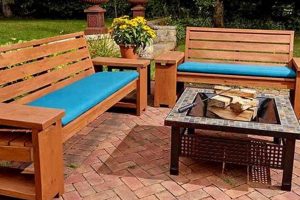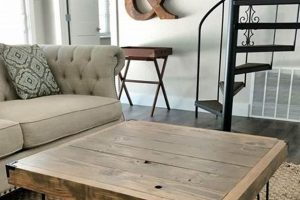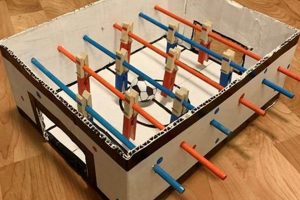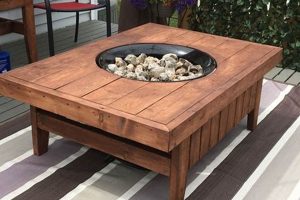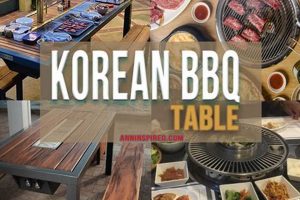A self-constructed support structure designed to house a Weber grill exemplifies resourceful outdoor cooking arrangements. These customized platforms offer an alternative to commercially available grill stands, often providing increased workspace and storage capabilities. Examples include tables built from reclaimed wood, repurposed cabinets, or modular designs incorporating tile or metal.
The creation of such a platform presents multiple advantages. Cost savings can be realized compared to purchasing a pre-fabricated unit. Individuals can tailor the dimensions, materials, and features to suit their specific needs and preferences, accommodating varying grill sizes and spatial constraints. The process allows for personalized aesthetics, seamlessly integrating the grill into the overall outdoor living area. Historically, similar handcrafted solutions have been prevalent in domestic settings where functionality and resourcefulness are prioritized.
The subsequent sections will elaborate on the key considerations for designing and building a customized grilling station, including material selection, construction techniques, safety protocols, and design variations that maximize functionality and aesthetic appeal. These elements are crucial for a durable and practical outdoor cooking environment.
Tips for Constructing a Weber Grill Support Structure
The following guidelines provide essential information for creating a stable and functional support for a Weber grill, emphasizing safety, durability, and optimal user experience.
Tip 1: Material Selection is Paramount: Opt for weather-resistant materials such as cedar, redwood, or treated lumber for outdoor use. Consider powder-coated steel for increased durability and resistance to corrosion. Avoid materials prone to warping or degradation in fluctuating temperatures.
Tip 2: Prioritize Structural Integrity: Employ robust joinery techniques, such as mortise and tenon joints or reinforced screw connections, to ensure stability. Bracing is crucial to prevent wobbling and maintain a level surface. A solid foundation is the cornerstone of safety.
Tip 3: Incorporate Heat Shielding: Implement a heat shield between the grill and the support structure to mitigate the risk of fire. Ceramic tiles, metal sheeting, or specialized heat-resistant insulation can effectively deflect radiant heat.
Tip 4: Account for Ventilation: Adequate ventilation around the grill is essential for proper combustion and prevents overheating. Design the structure with open spaces or vents to promote airflow.
Tip 5: Optimize Workspace and Storage: Integrate prep surfaces, utensil hooks, and storage compartments into the design. Strategically positioned shelves and drawers enhance efficiency and organization.
Tip 6: Consider Mobility: If portability is desired, attach heavy-duty locking casters to the base of the structure. Ensure the casters are rated to support the weight of the grill and any additional accessories.
Tip 7: Adhere to Safety Standards: Maintain a safe distance between the grill and any flammable materials. Keep a fire extinguisher readily accessible. Inspect the structure regularly for signs of wear or damage.
These tips are designed to guide the creation of a safe and functional grill support. By adhering to these principles, a durable and reliable structure can be achieved.
The subsequent sections will cover specific design considerations and provide detailed instructions for various construction methods. These elements will enable the creation of a custom solution that seamlessly integrates the grill into the outdoor cooking environment.
1. Dimensions and Ergonomics
Dimensions and ergonomics are critical determinants of user satisfaction and safety in the construction of a Weber grill support structure. The height of the work surface directly influences the user’s posture during grilling, impacting comfort and reducing the risk of strain. An inappropriately sized structure can lead to back pain, shoulder discomfort, or awkward reaching motions, compromising the grilling experience. For example, a table that is too low requires the user to stoop, increasing the likelihood of back problems over time. Conversely, a table that is too high forces the user to raise their arms excessively, leading to shoulder fatigue. Therefore, careful consideration of user height and preferred grilling posture is paramount when determining the optimal dimensions of the support.
Beyond overall height, the depth and width of the work surface also contribute significantly to ergonomic efficiency. Adequate space is needed for food preparation, placement of grilling tools, and temporary storage of cooked items. Insufficient space can lead to clutter and increase the risk of accidents, such as knocking over hot sauces or utensils. Furthermore, the placement of storage compartments and utensil hooks should be ergonomically sound, allowing for easy access without requiring excessive bending or reaching. A well-designed structure incorporates these elements to minimize unnecessary movements and optimize workflow, improving the overall grilling experience. A real-world example would be a support designed with a built-in shelf at knee level for storing charcoal, easily accessible without bending over.
In summary, the dimensions and ergonomic design of a Weber grill support structure are essential factors that directly impact user comfort, safety, and efficiency. Prioritizing these considerations during the planning and construction phases yields a more enjoyable and practical grilling experience. Neglecting these factors can result in discomfort, inefficiency, and potential safety hazards, undermining the benefits of a customized grilling station. The correct implementation of ergonomic principles ultimately ensures that the structure is not just functional but also conducive to a positive and sustainable grilling experience.
2. Material Durability
The selection of appropriate materials is paramount to the longevity and safety of any self-constructed Weber grill support structure. The outdoor environment presents a range of challenges, including exposure to moisture, temperature fluctuations, ultraviolet radiation, and potential physical impacts. Consequently, materials must be chosen with careful consideration of their inherent resistance to these degrading factors.
- Resistance to Weathering
Materials used in the construction of a Weber grill support must withstand constant exposure to rain, snow, and sunlight. Untreated wood, for instance, is susceptible to rot and warping, significantly reducing the lifespan of the structure. Examples of suitable materials include pressure-treated lumber, cedar, or redwood, which possess natural resistance to decay. Additionally, the application of protective coatings, such as sealants or paints specifically formulated for outdoor use, can extend the durability of less naturally resilient materials. The absence of proper weatherproofing measures will invariably lead to premature structural failure.
- Thermal Stability
The proximity of a grill to the support structure necessitates the selection of materials that can withstand elevated temperatures without compromising their structural integrity. Certain plastics, for instance, may soften or melt when exposed to heat, posing both a safety hazard and a structural risk. Materials such as metal, stone, or concrete offer superior thermal stability and are less prone to deformation or degradation under high-temperature conditions. Furthermore, the inclusion of heat shields or insulation between the grill and the support structure can mitigate the effects of radiant heat, allowing for a wider range of material options.
- Resistance to Corrosion
Metal components, such as fasteners, brackets, and support legs, are susceptible to corrosion, particularly in humid environments or areas with high salt content in the air. The use of stainless steel or galvanized steel offers superior corrosion resistance compared to untreated steel. Regularly inspecting and maintaining metal components, including the application of rust inhibitors or protective coatings, can prevent the onset and spread of corrosion, ensuring the long-term stability of the structure. Failure to address corrosion can lead to weakening of structural connections and eventual collapse.
- Impact Resistance and Load-Bearing Capacity
The selected materials must possess sufficient impact resistance and load-bearing capacity to support the weight of the grill and any associated accessories, such as propane tanks or grilling tools. Materials that are prone to cracking or splintering under stress are unsuitable for use in a Weber grill support. Dense hardwoods, reinforced concrete, or steel framing offer superior structural integrity and can withstand the demands of regular use. Overestimation of the required load-bearing capacity is preferable to underestimation, as structural failure can result in significant damage or injury.
The relationship between material durability and a self-constructed Weber grill support is inextricably linked. The long-term functionality and safety of the structure are directly dependent on the careful selection of materials that can withstand the rigors of the outdoor environment and the demands of regular use. Compromising on material quality in an attempt to reduce costs will invariably lead to premature failure and necessitate costly repairs or replacements. Therefore, prioritizing material durability is a critical investment in the longevity and value of a custom grilling station.
3. Structural Stability
The structural stability of a self-constructed Weber grill support directly impacts its safety, longevity, and overall utility. A stable structure provides a secure platform for the grill, preventing tipping or collapse, and ensuring a safe cooking environment. The following facets outline critical elements contributing to structural integrity.
- Joint Integrity and Load Transfer
The method by which individual components are connected significantly affects the structure’s ability to withstand applied loads. Robust joinery techniques, such as mortise and tenon, dovetail joints, or properly executed screw connections, are essential for distributing weight effectively. A weak joint can become a point of failure, leading to instability or collapse. Examples of inadequate joinery include using insufficient fasteners or failing to properly align and secure connecting members. The consequences of such failures range from minor inconveniences to serious safety hazards.
- Bracing and Reinforcement
Bracing elements, such as diagonal supports or cross-members, enhance structural rigidity by resisting lateral forces and preventing racking. These elements distribute stresses throughout the structure, minimizing the concentration of load on any single point. Without adequate bracing, the table may be susceptible to wobbling or collapsing under uneven weight distribution. Examples include incorporating triangular gussets at corners or adding a lower shelf that also functions as a horizontal brace. The absence of these features can compromise the table’s stability, particularly when moving the grill or placing heavy items on the work surface.
- Material Selection and Dimensional Considerations
The inherent strength and stiffness of the chosen materials, along with their dimensions, influence the overall structural capacity. Using undersized lumber or materials with inadequate load-bearing capabilities can compromise the structure’s ability to support the weight of the grill and related accessories. Selecting materials with appropriate thickness and ensuring adequate spacing between support members are crucial for maintaining stability. For example, a table constructed with thin plywood and widely spaced legs will be significantly less stable than one built with thicker lumber and closer leg spacing. Careful calculation of material properties and anticipated loads is essential for preventing structural failure.
- Foundation and Leveling
The stability of the support structure is also dependent on the foundation upon which it rests. Uneven ground or an unstable base can compromise the entire structure, leading to tipping or distortion. Ensuring a level and stable foundation is critical for maintaining structural integrity. Examples include placing the table on a concrete patio or using adjustable feet to compensate for uneven surfaces. Neglecting this aspect can introduce stress points and weaken the structure over time, increasing the risk of collapse.
These facets of structural stability are intricately linked in the creation of a secure Weber grill support. Addressing each element carefully ensures a safe and durable structure capable of withstanding the demands of regular use. Inadequate attention to any one of these areas can compromise the entire structure, highlighting the importance of a holistic approach to design and construction.
4. Heat Management
Effective heat management is a critical design consideration when constructing a support structure for a Weber grill. The uncontrolled transmission of heat from the grill to the surrounding structure can lead to material degradation, fire hazards, and compromised user safety. A direct cause-and-effect relationship exists: inadequate heat shielding results in elevated surface temperatures on the support structure, increasing the risk of combustion or burns. The importance of heat management lies in ensuring the structural integrity of the table, the safety of individuals using the grill, and preventing potential property damage. A practical example includes the scorching and eventual ignition of an untreated wooden table placed directly beneath a hot grill. The practical significance of understanding heat management principles is thus clear: informed design and construction are essential for a safe and durable grilling station.
Further analysis reveals various strategies for effective heat management. The incorporation of heat shields constructed from materials such as sheet metal, ceramic tiles, or specialized heat-resistant insulation provides a barrier against radiant heat transfer. Proper ventilation is equally important, allowing for the dissipation of heat away from the structure. Design examples include incorporating air gaps between the grill and the table surface, utilizing perforated metal panels for increased airflow, and strategically placing ventilation openings to facilitate convective cooling. The specific materials and construction techniques employed should be tailored to the grill’s heat output and the surrounding environment. In applications where high heat output is expected, enhanced shielding and ventilation are crucial.
In conclusion, the integration of appropriate heat management techniques is not merely an ancillary consideration but a fundamental requirement for any self-constructed grill support. Challenges in this area include selecting cost-effective yet effective heat-resistant materials and implementing ventilation strategies that do not compromise structural integrity. A comprehensive understanding of heat transfer principles and careful attention to design details are essential for mitigating risks and ensuring a safe, functional, and long-lasting outdoor cooking environment. The responsible construction of a grilling station demands a proactive approach to heat management.
5. Integrated Storage
The incorporation of storage solutions within a self-constructed Weber grill support enhances functionality and promotes organization in the outdoor cooking space. Thoughtful integration of storage options optimizes the grilling experience by providing convenient access to essential tools, supplies, and accessories.
- Dedicated Utensil and Tool Organization
Provision for readily accessible utensils and grilling tools reduces the need for constant trips to indoor kitchens. Hooks, racks, or dedicated drawers facilitate the organized storage of spatulas, tongs, brushes, and thermometers. An example includes a built-in magnetic strip for securing metal tools, preventing them from cluttering the workspace. This targeted organization contributes to a more efficient and streamlined grilling process.
- Fuel and Supply Containment
Designated storage for charcoal, propane tanks, or wood chips minimizes clutter and promotes safety. Enclosed compartments protect fuel sources from the elements, preventing moisture damage or accidental ignition. For instance, a vented cabinet specifically sized for a propane tank ensures safe storage and easy access when needed. Proper containment of fuel and supplies is essential for maintaining a safe and organized grilling area.
- Prep Surface Enhancement through Strategic Placement
Integrated storage can supplement prep surfaces by providing readily accessible ingredients and seasonings. Shelves or drawers positioned near the primary work area enable efficient food preparation. An example is a pull-out drawer containing commonly used spices and sauces, reducing the need to move away from the grill during cooking. This proximity minimizes interruptions and maximizes efficiency.
- Waste Management Integration
The inclusion of a waste receptacle or designated area for trash disposal contributes to cleanliness and hygiene. A built-in trash can holder prevents unsightly messes and simplifies cleanup after grilling. For example, a concealed container with a hinged lid provides easy access for waste disposal while maintaining a tidy appearance. Effective waste management promotes a more pleasant and sanitary grilling environment.
The considered integration of these storage facets significantly elevates the practicality of a self-constructed Weber grill support. The added convenience and organization not only enhance the grilling experience but also contribute to a more aesthetically pleasing and functional outdoor cooking space. Strategic storage solutions are essential for maximizing the utility of such a structure.
Frequently Asked Questions
The following questions address common inquiries and misconceptions regarding the design, construction, and maintenance of self-built support structures for Weber grills.
Question 1: What is the optimal height for a grill support work surface?
The ideal height of a grill support work surface is generally between 36 and 42 inches, aligning with standard kitchen counter heights. This range promotes ergonomic comfort and reduces strain during prolonged grilling sessions. The specific height should be adjusted based on the primary user’s height and arm length for optimal comfort.
Question 2: Which materials provide the best heat resistance for a grill support?
Materials such as ceramic tile, concrete, and metal offer superior heat resistance compared to wood or plastic. When using wood, a heat shield constructed of metal or ceramic insulation is essential to prevent scorching or combustion. Proper ventilation around the grill also aids in dissipating heat.
Question 3: How can structural stability be ensured in a self-built grill support?
Structural stability is achieved through robust joinery techniques, adequate bracing, and the use of appropriately sized materials. Joints should be reinforced with screws, bolts, or adhesive to prevent loosening over time. Diagonal bracing adds rigidity and prevents racking. The overall design should distribute weight evenly across the structure.
Question 4: What safety precautions should be observed during the construction process?
Appropriate safety measures include wearing safety glasses, gloves, and hearing protection when using power tools. All cuts should be made accurately and safely, following manufacturer’s instructions. Ensure a clear and well-ventilated workspace to prevent accidents and exposure to harmful fumes.
Question 5: How can storage be effectively integrated into a grill support design?
Storage solutions can be incorporated through the addition of shelves, drawers, or cabinets. The placement of these elements should be strategic, allowing for easy access to grilling tools, fuel, and accessories. Consider the weight capacity of shelves and drawers when storing heavy items such as charcoal or propane tanks.
Question 6: What maintenance is required to prolong the lifespan of a self-built grill support?
Regular maintenance includes cleaning the work surface, inspecting joints for loosening, and applying protective coatings to prevent weathering. Metal components should be inspected for rust and treated with rust inhibitors as needed. Promptly address any signs of damage or wear to prevent further deterioration.
These FAQs highlight crucial considerations for individuals undertaking the construction of a Weber grill support. Prioritizing safety, durability, and functionality ensures a successful and long-lasting project.
The subsequent sections will explore specific design variations and detailed construction plans for various Weber grill support structures.
DIY Weber Table
This exploration of the diy weber table construct has elucidated the critical facets of design, material selection, structural integrity, heat management, and integrated storage. A successful implementation demands a comprehensive understanding of these principles to ensure a safe, durable, and functional grilling environment. Overlooking fundamental aspects, such as adequate heat shielding or robust joinery, compromises the entire project.
The creation of a custom grill support necessitates diligent planning and meticulous execution. Its significance resides not only in cost savings and personalization but, more importantly, in the responsible creation of a long-lasting and safe outdoor cooking station. Therefore, prospective builders must approach this endeavor with informed decision-making and a commitment to established construction standards. Further research and consultation with experienced builders are highly recommended to achieve optimal results.


